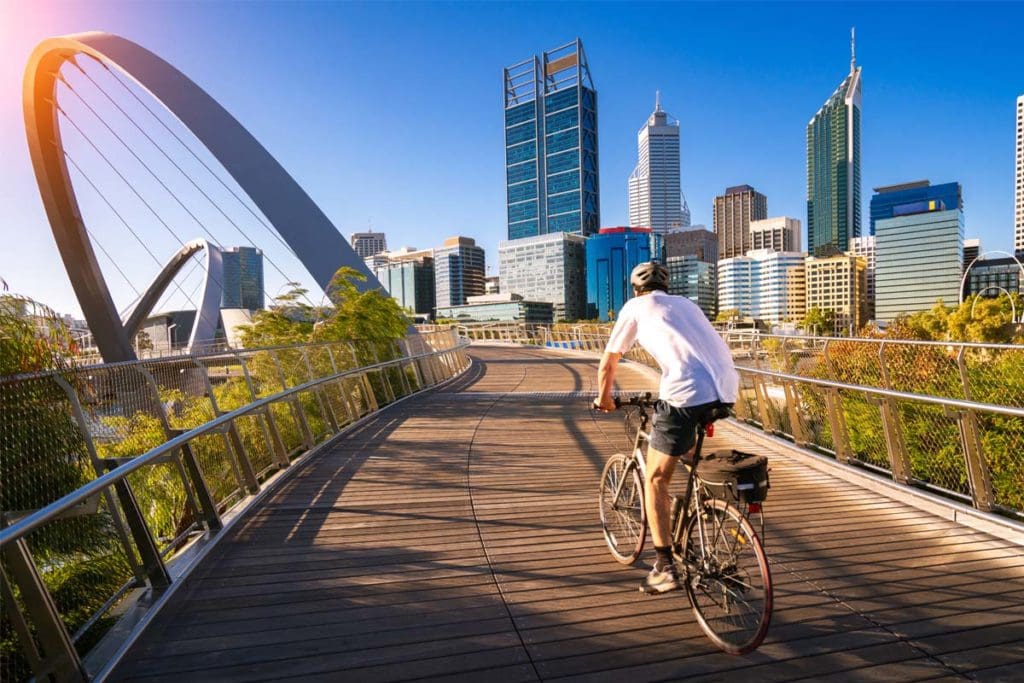Record Spending for Active Transport in WA Budget

Perth, WA
Active transport infrastructure in WA is set to be boosted a four-year $347 million allocation in the State Budget last month.
The 2022-23 WA Budget includes:
- $47 million to further expand local bicycle infrastructure through the Western Australian Bicycle Network (WABN) Grants Program and other projects
- $62 million to continue the Principal Shared Path (PSP) Expansion Program, including closing gaps on the cycle route along the Armadale train line
- $46 million for riding and walking facilities as part of major infrastructure projects including the Swan River Crossing Project, Mitchell Freeway projects and Tonkin Highway Extension
- $35 million for a pedestrian and cycling bridge in East Perth connecting the community and train station
- $157 million through the Perth City Deal, including the Causeway Pedestrian and Cyclist Bridge
Transport Minister Rita Saffioti highlighted the need for infrastructure that is continuous across local government boundaries.
“Over the past four years we have delivered more than 150km of high-quality shared pathways for walking and cycling across WA, providing Western Australians with various opportunities to travel around the State,” she added.
“In 2022-23, we look forward to continuing work on the Fremantle line shared path and further increasing our investment in the Western Australian Bicycle Network Grants Program to provide even more opportunities for those who want to ride for leisure, fitness or as part of their daily commute.
“In our regions, investing in safe and attractive bicycle infrastructure, such as expanding the Geraldton cycling network and facilitating long-term network planning projects in Kalgoorlie and the Great Southern and Gascoyne regions, will provide opportunities to showcase some of the State’s best natural landscapes while also forming important recreational assets for the community.”
The Budget allocation was “good news for bike riders out west”, according to cycling advocacy group Bicycle Network. However, it points out active transport projects still only comprise two percent of total transport budget, well below the UN recommendation of 20%.
Victorian Budget
The Melbourne-based organisation said it was still positive news, following the “comparatively meagre” $21.8 million active transport allocation in the Victorian Budget a week earlier.
Similarly, Bicycle Industries Australia CEO Peter Bourke described the Victorian Budget’s investment in cycling projects as disappointing, “reinforcing how little interest the current State Government has in active travel”.
Peter said it would fuel concerted lobbying of all sides of politics ahead the State election in November.
He noted the Budget came amid a large and ongoing media campaign against bike lanes in the Melbourne city centre.
“Not that I believe that would impact on the Budget but it shows that, like everywhere, bike infrastructure can be a political football,” he explained.
Peter said while Victoria has typically led NSW in active transport, Victorians were currently in a rare situation of looking at their northern neighbours with a level of envy, particularly with the NSW Government’s recent creation of an Active Transport portfolio and the energetic drive displayed by the first Minister in the post, Rob Stokes.
A statement from the State Government says: “The 2022/23 Victorian Budget continues our strong track record of delivering a better transport network for everyone, regardless of how you choose to travel.
“Since 2014, the Andrews Labor Government has invested over $280 million into the planning and delivery of a range of active transport initiatives across the state, including the recent investment of $21.8 million as part of the 2022/23 Victorian Budget.
“Our $90 billion Big Build program has already delivered more than 100km of walking and cycling paths, with a further 150km under development, while our Pop-Up Bike Lane Program is delivering up to 100km of new and improved cycling lanes across inner Melbourne.
“Each and every Big Build project adds something to the active transport network. We’re not only upgrading road and rail infrastructure, but linking people with active transport options and creating great community spaces along the way.”
Join the Conversation
Is it realistic to think government spending on active transport in Australia can reach the UN benchmark of 20% of total transport funding? What would need to change?
